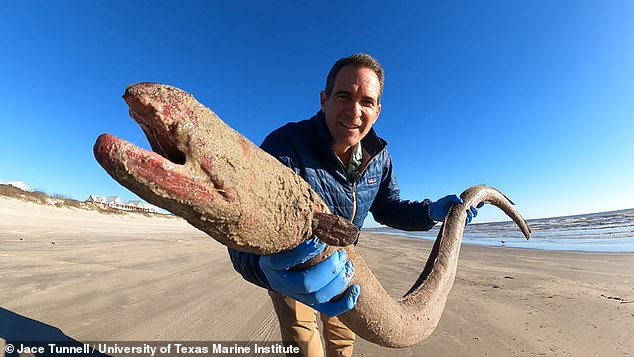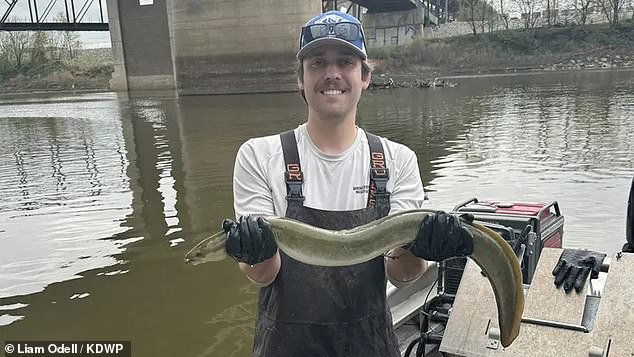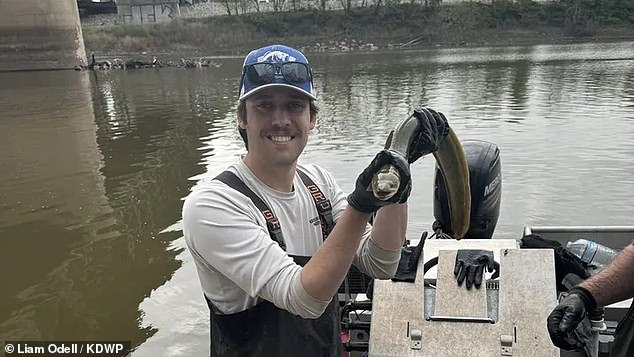Human-sized sea monsters found 3,500 miles away from home as they invade Kansas river
A slippery, yellow-green ocean creature born in cold, deep water northeast of the Caribbean has been pulled from the Kansas River – 3,500 miles from its birthplace.
The American eel, which can grow up to five feet long and weigh as much as six pounds, is native to the U.S. but is rarely seen this far inland in modern times.
The eel usually lands on American shores within the first year of its life as a small, transparent “glass eel,” before maturing and wandering and feeding along coastal rivers and nearby ocean habitats.
This specimen was the first American eel documented in Kansas since 2015.
But even the rare American eel that has managed to dive so deep into America’s inland rivers will find its way back to the Atlantic Ocean to spawn – which American eels do as their final act, with females releasing millions of eggs before dying.
The first American eel spotted in Kansas in more than a decade was discovered by an invasive species team dispatched by the Kansas Department of Wildlife and Parks (pictured). The team’s task, among other things, is to stop the spread of Asian silver carp and bighead carp

Last year, for his #Beachcombing series, Jace Tunnell of the University of Texas Marine Institute identified what an American eel would be much closer to its maximum size of five feet. This specimen, a King Snake Eel or an American Eel, was found off the Gulf of Mexico
“Many mysteries still remain in the life history of the American eel,” experts say. ‘They arrive on our coast with an unknown sex and years later swim more than a thousand miles offshore to spawn once and die.’
The rare inland specimen of the American eel was discovered by an invasive species team dispatched by the Kansas Department of Wildlife and Parks (KDWP), whose mission includes halting the spread of Asian silver carp and bighead carp call.
But the crew took a break to pose with the eel, the first confirmed sighting of its species in Kansas in nearly a decade.
The KDWP Aquatic Invasive Species Crew found the eel during a sampling operation near Kaw Point, a river bend where the Kansas and Missouri rivers meet.
“Any American eel found in Kansas began its journey in the Sargasso Sea and will have traveled approximately 3,500 miles,” the wildlife agency noted.
The Sargasso Sea, unlike most landlocked seas, is a part of the Atlantic Ocean surrounded by a large, rotating series of four currents.
This calm blue region, where American eels travel to spawn and then end their lives, is named for the unique brown Sargassum seaweed.
This death drive to reproduce is a characteristic these eels share with Pacific salmon and similar species that marine biologists and fish experts describe as “semelparous.”

The KDWP Aquatic Invasive Species Crew found the American eel (photo) while conducting sampling operations near Kaw Point, a river bend where the Kansas and Missouri rivers meet

While the American eel (above) was once a common sight in coastal rivers up and down the Western Hemisphere, from Greenland to Brazil, and as far inland as Minnesota and central New Mexico, dam projects have halted migration patterns.
“Spawning occurs during late winter and early spring,” as KDWP wrote in its post Facebook pagecontaining a map of “the long, strenuous swim that this eel and all other American eels in Kansas had to endure to arrive here.”
While the American eel was once a common sight in coastal rivers up and down the Western Hemisphere, from Greenland to Brazil, and as far inland as Minnesota and even central New Mexico, dam projects have halted its migration.
The species, which can live up to 25 years, is now most often seen only in oceans and river systems closer to the coastline.
Nevertheless, like the Massachusetts Department of Marine Fisheries explains on the facts page that the American eel still occupies “the most diverse habitats among fish in North America.”
“They live along the entire east coast,” the group continued, “ranging from Canada through the Caribbean, and south to French Guiana in South America.”
In 2015, a local recreational fisherman fishing at Bowersock Dam on the Kansas River became the last person to pull a confirmed American eel specimen in the state.
As then head of the KDWP Fisheries Department, Doug Nygrenas it explained at the time, this specimen was just over two feet long (30 inches): a typical size for adult American eel.
“This eel has made a long journey,” Nygren said, “from the Atlantic Ocean, through the Gulf of Mexico, up the Mississippi, took an exit at St. Louis to enter the Missouri River, and another bend to enter the Kansas River. to Bowersock Dam.”
